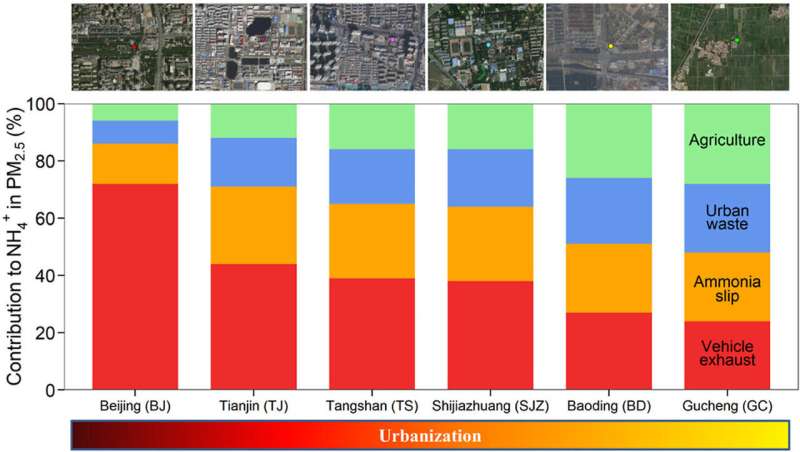Credit: Environmental Pollution (2022). DOI: 10.1016/j.envpol.2022.120376
The haze pollution that frequently occurred in winter in cities of North China has aroused widespread concern. Since the implementation of Air Pollution Prevention and Control Action Plan in 2013, the atmospheric concentration of acidic gases such as sulfur dioxide and nitrogen oxides have significantly decreased in this region. However, the concentration of ammonia gas (NH3) and inorganic ammonium (NH4+) salts such as ammonium sulfate and ammonium nitrate in atmospheric aerosol particles were still increasing.
Ammonia gas (NH3), combined with acidic gases in the atmosphere, can form precursors of PM2.5 (small atmospheric aerosol Particulate Matter in air that are 2.5 micrometers or less in diameter) and increase the contribution of ammonium deposition to atmospheric nitrogen deposition. Measuring nitrogen stable isotope natural abundance (δ15N) is an effective and rapid approach for the source detection of NH4+ in PM2.5, and it is vital for the formulation of reasonable air pollution control schemes.
Researchers Abubakari Said Mgelwa and FANG Yunting from the Institute of Applied Ecology of the Chinese Academy of Sciences, together with Prof. ZHANG Yanlin's team at Nanjing University of Information Science & Technology, have collected PM2.5 samples in Beijing, Tianjin, Baoding, Shijiazhuang, Tangshan and Gucheng, and measured ammonium concentrations and natural 15N abundance of ammonium (δ15N-NH4+) in PM2.5 particulates.
The researchers found that on polluted days (defined as days with PM2.5 concentration below 35 μg m-3), the average atmospheric concentration of NH4+ was almost three times of that on unpolluted days (PM2.5 > 35 μg m-3) in the six cities.
They found that vehicle exhaust emission and urban ammonia slip, two non-agricultural sources of NH4+ in the atmosphere, together accounted for 56%–86% and 72%–94% of atmospheric NH4+ concentration on the polluted and unpolluted days respectively, depending on the degree of urbanization of the cities.
Specifically, the combustion-related NH4+ sources, the vehicle exhaust emission especially, was positively correlated with the population density, the proportion of urban area and the number of vehicles in use in the six cities.
These results highlight the critical impacts of local emission sources to the formation of atmospheric haze pollution and the importance of δ15N analysis for the source detection of ammonia and ammonium in the atmosphere.
This study has been published in Environmental Pollution, titled "Isotopic imprints of aerosol ammonium over the north China plain."
More information: Abubakari Said Mgelwa et al, Isotopic imprints of aerosol ammonium over the north China plain, Environmental Pollution (2022). DOI: 10.1016/j.envpol.2022.120376
Journal information: Environmental Pollution
Provided by Chinese Academy of Sciences
























